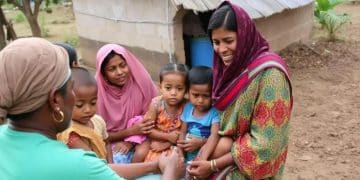Broadband access grants: enhance your internet experience

Broadband access grants provide essential funding for improving internet connectivity in underserved areas, enhancing economic growth, education, and healthcare services in communities.
Broadband access grants are vital for improving internet connectivity in underserved areas. Have you ever wondered how they could change your online experience? Let’s explore the potential of these grants and their impact on your community.
Understanding broadband access grants
Understanding broadband access grants is crucial for anyone looking to improve internet connectivity. These grants are designed to support communities and organizations by providing the necessary funding to expand broadband services.
With increasing reliance on the internet for education, work, and everyday life, having fast and reliable internet is more important than ever. Grants are available at federal, state, and local levels, making it possible for those who might not otherwise afford necessary improvements.
How do broadband access grants work?
Broadband access grants typically come from government programs aimed at closing the digital divide. They help fund projects that improve or create broadband infrastructure in underserved areas. This funding can cover various costs, including:
- Equipment and technology upgrades
- Installation of new cables and networks
- Community outreach and awareness programs
Who is eligible for these grants?
Eligibility for broadband access grants can vary widely based on the specific grant program. Generally, the following entities can apply:
- Local governments and municipalities
- Nonprofit organizations
- Educational institutions
- Private sector companies willing to provide services in underserved areas
It’s essential for applicants to carefully review the eligibility requirements to ensure that they meet all criteria before applying.
A significant advantage of these grants is that they can lead to better access to education and job opportunities. For instance, communities with high-speed internet are more likely to see economic growth and innovation. The right grant can transform your community’s internet landscape.
Eligibility criteria for applying
Eligibility criteria for applying for broadband access grants are an essential aspect to understand. These criteria determine who can access funding to improve internet services in their communities. Each grant program will have its specific requirements, but some common factors help frame the eligibility landscape.
Typically, eligibility includes local, state, or tribal governments, nonprofit organizations, or educational institutions that aim to enhance internet access. These entities often need to demonstrate the potential for community impact and outline their plans for the funding.
Common eligibility requirements
Here are key factors that applicants must consider:
- Geographic area served: The program often targets specific underserved regions.
- Type of project: Applicants need to focus on projects that will significantly improve broadband access.
- Partnerships: Collaboration with local entities may strengthen applications.
- Experience and capacity: Demonstrating previous experience in similar projects can be a plus.
Having a clear understanding of these requirements is crucial. It helps organizations prepare and tailor their proposals effectively. Applicants should also focus on presenting how their project aligns with community needs and priorities. Engaging with community stakeholders can provide valuable insights and support for the application process.
Moreover, staying updated on grant announcements and deadlines is vital. This proactive approach ensures that interested parties do not miss out on funding opportunities that could enhance their area’s internet services.
Benefits of broadband access grants

The benefits of broadband access grants extend far beyond just improving internet speeds. These grants play a vital role in enhancing community development and providing opportunities that were previously unavailable. Whether for educational institutions, businesses, or nonprofit organizations, the advantages are numerous and impactful.
One significant benefit is increased economic growth. With better internet access, local businesses can expand their reach online, connecting with more customers. This connection can lead to job creation and a more robust local economy. Additionally, individuals have greater access to job opportunities, improving overall economic stability.
Enhanced educational opportunities
Broadband access grants also lead to better educational outcomes. Schools and libraries can obtain the technology they need to provide online resources and tools. Students can access valuable information from anywhere, allowing for improved learning experiences. This access also enables remote learning, which has become increasingly important.
Improved healthcare access
Another crucial benefit is the improved access to healthcare services. Telehealth has emerged as a key service, allowing patients to consult with healthcare providers remotely. With the support of broadband access grants, communities can implement telehealth services that help individuals receive care without needing to travel long distances.
- Access to specialist consultations from home
- Faster sharing of medical records
- Lower travel costs for patients
- Improved monitoring of chronic conditions
Moreover, these grants can foster social equity by ensuring that underserved communities gain access to vital internet services. In today’s digital world, having stable internet is not just a convenience; it’s a necessity that helps bridge the divide between different socioeconomic groups.
As broadband access expands, communities begin to see transformations that can alter residents’ daily lives. The ripple effect of better internet connectivity can create a more informed, healthier, and vibrant community, showcasing the far-reaching benefits of these essential grants.
How to apply for broadband access grants
Applying for broadband access grants can be a straightforward process if you understand the necessary steps. Many organizations and communities can benefit from these grants, but preparing a strong application is key. Knowing how to navigate the application process makes a significant difference.
First, identify the specific grant program that suits your needs. Each grant may have different requirements and focus areas, so it’s important to align your project with the goals of the funding source. Once you have the right program in mind, you can begin preparing your application.
Gather necessary documents
You’ll need to collect several important documents before starting your application. These usually include:
- A project plan that details your objectives and methods
- Evidence of community need, such as surveys or research
- Budget estimates showing how the grant money will be used
- Letters of support from community partners or stakeholders
The more comprehensive your application, the better your chances of securing funding. Each document plays a role in telling a story about why your project matters.
Write a strong proposal
Next, focus on your proposal. A clear and compelling proposal outlines the impact of your project. Explain how the grant will help improve broadband access and benefit your community. Ensure that you highlight the following:
- The specific problems your project aims to solve
- The expected outcomes and benefits for the community
- Your implementation timeline and resources needed
Getting feedback from peers or community members can strengthen your proposal further. They may offer valuable insights or suggestions to improve clarity and effectiveness.
Finally, submit your application before the deadline. Make sure to follow all submission guidelines carefully. After submitting, be prepared to answer any additional questions from the grant committee. This part of the process can lead to clarifying your intentions and project goals, increasing your chances of receiving funding.
Success stories from grant recipients
Success stories from grant recipients highlight the transformative impact of broadband access grants on communities. These real-world examples illustrate how funding can create significant change, improving lives and fostering growth.
One notable success story comes from a rural town where a local nonprofit organization received a broadband grant. With this funding, they were able to set up high-speed internet service in previously underserved areas. The result? Residents reported increased job opportunities, better access to online education, and improved healthcare services through telehealth.
Case study: The city of Walnut Springs
In Walnut Springs, the community center used a broadband grant to upgrade their internet service. They started a program for seniors to learn digital skills, connecting them with family and providing access to essential online resources.
- Over 100 seniors participated in the program.
- Local businesses reported increased customers due to online advertising.
- Students gained access to valuable online tutoring services.
This initiative helped create a more connected and informed community. It empowered seniors and brought residents together, demonstrating the potential of what broadband access can achieve.
Community engagement and growth
Another inspirational example is a small town library that received a broadband grant. After upgrading their internet services, they began hosting programs for the community. These programs included:
- Workshops on job searching and resume building.
- Classes on digital literacy for all age groups.
- Community meetings held via video conferencing to involve more residents.
Thanks to the grant, the library became a hub of community engagement, fostering collaboration and learning. These stories show how broadband access grants drive local empowerment and enhance community life.
As more communities share their success stories, the importance of securing funding through broadband grants becomes clearer. This funding is not just about technology; it’s about creating opportunities that uplift and connect community members.
broadband access grants play a crucial role in elevating communities by providing better internet access. They lead to economic growth, improved education, and healthcare services, empowering residents to seize new opportunities. The inspiring success stories from grant recipients showcase how funding can transform lives and foster connections. Through careful planning and application, many communities can benefit from these grants, ensuring a brighter and more connected future for everyone.
FAQ – Frequently Asked Questions about Broadband Access Grants
What are broadband access grants and what do they fund?
Broadband access grants provide funding to improve internet services in underserved areas, covering costs for infrastructure, technology upgrades, and community outreach.
Who is eligible to apply for these grants?
Eligibility often includes local governments, nonprofit organizations, educational institutions, and private sector companies that aim to enhance broadband access in their communities.
What are some benefits of receiving a broadband access grant?
Benefits include improved internet access, enhanced educational opportunities, better healthcare services, and increased economic growth within the community.
How can communities showcase their success with these grants?
Communities can share success stories through presentations, reports, or social media, highlighting the positive impact of improved internet access on education, healthcare, and local businesses.





